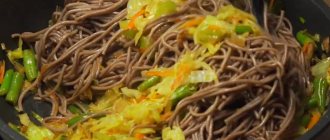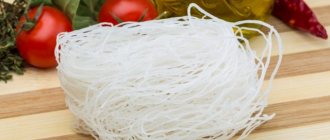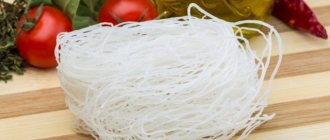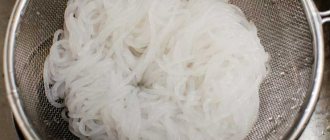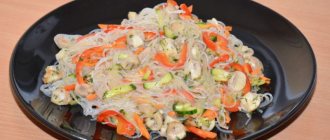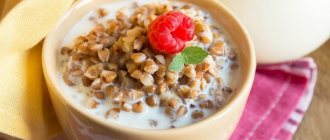Buckwheat noodles are Japanese noodles made from buckwheat flour. It is considered a dietary option, which is much healthier than analogues made from premium white flour, which in our country are consumed by the entire population.
- Culinary traditions of East and West
- Features of buckwheat noodles
- Effect on the body
- Energy value and composition
- Preparation
- How to use
- Soba Noodle Recipes
Chemical composition of buckwheat noodles
Buckwheat noodles have recently become especially popular. In terms of taste, it is in no way inferior to other types of pasta, but significantly surpasses them in terms of benefits. Buckwheat noodles are also called by the term Soba. She is of Japanese descent. The product is prepared from water and buckwheat flour and is brown in color. To obtain a sticky consistency, add a little rice flour to the dough. There are no dyes, preservatives or sugar in the composition. Due to this, buckwheat vermicelli is in demand among supporters of a healthy lifestyle.
A distinctive feature of buckwheat noodles is its rich chemical composition. The production process uses technologies to preserve the original properties of buckwheat. First of all, the product is valued for its content of plant proteins. The amount of fat is minimal.
The noodles contain the following elements:
- fat-soluble vitamins B, A and E;
- calcium;
- manganese;
- copper;
- zinc;
- sodium;
- iron;
- choline;
- phosphorus;
- potassium.
Soba contains a record amount of amino acids and antioxidants.
When purchasing buckwheat products, you should pay special attention to assessing the composition. In addition to the main component, it may contain rye or wheat flour. In this case, the calorie content of the dish will be higher, and the benefits will be significantly reduced. Therefore, you do not need to focus solely on the appearance of the product. Some manufacturers add green tea to the composition, thereby increasing the benefits of soba.
Attention! Buckwheat noodles prepared at home are considered the healthiest and most delicious.
Beef and buckwheat noodle soup
This traditional Japanese dish is quite suitable for dietary nutrition.
What ingredients will you need?
- 1 tbsp. l. dashi concentrate;
- 1 tsp. fresh ginger, grated
- 0.25 tbsp. soy sauce;
- 2 tbsp. l. Mirina;
- 1 medium sized carrot, cut into strips;
- 100 g broccolini, cut into florets;
- 1 bunch Pak Choy, chopped;
- 1 tbsp. l. peanut butter;
- 450 g beef tenderloin, thinly sliced;
- 270 g soba noodles made from 100% buckwheat;
- 1 tsp. sesame oil;
- 1 bunch green shallots, thinly sliced.
Step-by-step cooking process
- You need to combine dashi powder, ginger, 2 tbsp. l. soy sauce, 1 tbsp. l. mirin and 2 liters of cold water in a large saucepan, heat to a boil over high heat, turn down the heat and cook without a lid for 5 minutes, remove from the stove and cover.
- Meanwhile, boil, steam or microwave the carrots, broccolini and pak choi separately until they are soft.
- Next, you need to heat the oil in a wok or large non-stick frying pan over high heat and fry the beef in batches for 3-4 minutes. or until browned, add remaining soy sauce and mirin and cook, stirring, 1 to 2 minutes. or until the meat has absorbed the liquid, then transfer to a bowl and cover with foil.
- Meanwhile, cook the noodles in a separate pan of salted water until they are soft, then drain.
- Place the cooked soba into serving bowls, add the beef and vegetables, pour in the dashi broth and serve with a drizzle of sesame oil and sprinkled with shallots.
What are the benefits of buckwheat noodles?
Buckwheat noodles are most widespread in Asian countries. It is considered one of the healthy dietary products. It is indicated for use by those who have problems with the heart, blood vessels and suffer from surges in blood pressure. Women add it to their diet to preserve youth and beauty. For men, a buckwheat product helps them recover faster after active physical activity. The beneficial properties of buckwheat noodles include the following:
- acceleration of metabolic processes;
- prevention of cardiovascular diseases;
- normalization of sleep;
- replenishment of iron reserves in the body;
- antioxidant effect;
- help with weight loss;
- positive effect on skin condition;
- normalization of intestinal motility;
- activation of the body's defenses;
- improved vision;
- restoration of energy reserves.
Soba is very beneficial for hypertensive patients. It contains substances that stabilize blood pressure and strengthen blood vessels. With regular use, the product is able to remove heavy metal salts and toxins from the body. In addition, it has a stimulating effect on the gastrointestinal tract.
Useful tips
- Getting creative with buckwheat noodles can make losing weight simple and fun. First, you should buy soba that is 100% buckwheat. All buckwheat noodles are healthy and low in calories, so they can be a good basis for your diet.
- To make soba noodle dishes ideal for weight loss, you need to focus on using plenty of vegetables. For example, broccoli, bok choy and spinach are high in vitamins and minerals and low in carbohydrates and fat. For example, broccoli contains 80 mg of vitamin C and 92 mcg of vitamin K, which is almost the full daily value of both of these compounds.
- In addition, you need to add healthy protein to dishes with buckwheat noodles. Lean meats (such as chicken) are a great option for weight loss. Tofu, which is often used in noodle dishes, also has high levels of protein, calcium, magnesium and zinc. In addition, you can add a fried egg on top of the cooked soba - it is also a good source of protein, vitamins A and B12.
- Finally, you can make buckwheat noodles spicier, or add more flavor with low-fat sauces and spices. When losing weight, you can use chopped or grated garlic, red pepper flakes, ginger, green onions, salt, sesame oil or chili oil to add more flavor to your food.
How many calories are in buckwheat noodles?
The benefits of buckwheat noodles for weight loss are invaluable. 100 g of the finished product contains 115 kcal. Even if you take into account the additional components, the dish will turn out to be dietary. That is why it is in particular demand among those losing weight. Nutritionists recommend eating soba with vegetables. A positive effect on the figure is due to the ability of buckwheat noodles to trigger metabolism.
Soba goes well with tuna and avocado
We recommend reading: Useful properties and contraindications of avocados
Comment! A diet that includes soda in the diet helps eliminate bad cholesterol from the body.
Contraindications for buckwheat noodles
Despite many beneficial properties, buckwheat vermicelli has contraindications. The main ones include an allergic reaction. Most often it occurs in preschool children. Allergies can be either acute or cumulative. In addition, the product is prohibited for use by people with gluten intolerance. Soba is allowed during pregnancy and breastfeeding. It does not have a negative effect on the fetus.
We recommend reading: Gluten: what it is and why it is harmful, where it is found, symptoms of intolerance
Rules for eating buckwheat noodles
Buckwheat noodles should be boiled before use. Cooking time is 10-15 minutes. If the product is not fully prepared, its use will cause heaviness in the stomach. After removing from the heat, place the noodles in a colander to remove excess moisture. Additional components are prepared in a separate container. At the end they are added to the base of the dish. The daily norm is 200 g.
Buckwheat noodles go well with seafood, soy sauce, vegetables and meat. It can be eaten both hot and cold. Most often, soba is served as a side dish, but sometimes it is the main component of the soup. Dishes prepared with buckwheat vermicelli are recommended to be consumed no more than 3 times a week. It is also undesirable to eat it several times a day. Excessive consumption depreciates the beneficial qualities of the product.
Recipe with young peas and carrots
This is a healthy recipe for a colorful dish made with soba noodles and fresh baby vegetables. In addition to green peas, you can add bell peppers, broccoli and much more.
What ingredients will you need?
For noodles with vegetables:
- 180 g soba noodles;
- 2 tbsp. frozen edamame beans;
- 3 tbsp. young peas;
- 6 medium sized carrots, peeled;
- 0.5 tbsp. chopped fresh cilantro (about 2 handfuls);
- 0.25 tbsp. sesame
For the ginger-sesame sauce:
- 0.25 tbsp. tamari or light soy sauce;
- 2 tbsp. l. quality peanut or olive oil;
- juice of 1 small lime;
- 1 tbsp. l. toasted sesame oil;
- 1 tbsp. l. honey or agave nectar;
- 1 tbsp. l. white miso paste;
- 2 tsp. grated ginger;
- 1 tsp. chili garlic sauce or sriracha.
Step-by-step cooking process
- It is necessary to cut the carrots into long thin strips using a vegetable peeler or a sharp knife.
- To prepare the sauce, you need to whisk all the ingredients in a small container until an emulsion is formed.
- Next, you need to heat 2 large pots of water to a boil and at the same time fry the sesame seeds in a dry frying pan for 4-5 minutes. over low heat, stirring frequently to prevent burning.
- As soon as the water boils, boil the buckwheat noodles in one pan until al dente, according to the recommendations on the package (about 5 minutes), then drain the liquid and quickly rinse the product under cool water.
- Frozen edamame should be boiled in another pan for about 4-6 minutes, the last 30 seconds. cooking, add green peas to the beans and heat quickly, then drain all the water.
- Next, combine the soba noodles, edamame, peas and carrots in a large serving bowl, pour in the sauce and stir.
What can I add?
In this dish, young peas can be replaced with other seasonal vegetables. For example, chopped raw bell peppers make a great addition to buckwheat noodles and sauce.
How to serve
It is recommended to sprinkle the finished dish with chopped cilantro and toasted sesame seeds and serve immediately.
Uses of buckwheat noodles
Most often, buckwheat noodles are included in the diet for variety. But sometimes it is used for weight loss purposes. The substances present in its composition trigger metabolic processes, promoting fat burning. At the same time, the dish perfectly satisfies the feeling of hunger without putting extra pounds on your figure. Noodles are quickly absorbed by the body, having a positive effect on health. The abundance of vitamins in its composition will prevent the skin from losing its elasticity during weight loss. Soba will be an excellent option for decorating a holiday table, and is also ideal for daily consumption.
For people involved in sports and pregnant women, soba can be a source of iron. It quickly replenishes the body's energy reserves and prevents the development of vitamin and mineral deficiencies. During pregnancy, the presence of the product in the diet prevents the development of iron deficiency anemia. Buckwheat noodles are recommended for women to use because they add beauty to the skin and hair. The vitamins in its composition make the epidermis more elastic, and the hair shiny and strong.
Important! Home-cooked soba should be kept away from moisture. The ideal container would be a canvas bag or a plastic container with a lid.
Soba with chicken and peanuts
To lose weight, you need to include lean sources of protein in your daily diet. A good example is this dietary recipe for buckwheat noodles with chicken and peanuts with the addition of sweet peppers, cabbage and aromatic sauce. The advantage of this dish is that it only takes about 30 minutes to prepare.
What ingredients will you need?
For the sauce:
- 0.5 tbsp. light soy sauce;
- 0.5 tbsp. water;
- 2 tbsp. l. honey;
- 2 tbsp. l. rice vinegar;
- 2 tbsp. l. peanut butter, unsalted;
- 2 large garlic cloves, minced;
- 2 tsp. corn starch;
- Sesame oil.
For the chicken noodles:
- 180 g soba noodles;
- 500 g boneless, skinless chicken breast, cut into thin slices;
- 2 large bell peppers, cut into thin strips;
- 4 tbsp. cabbage, coarsely chopped and tightly packed;
- 0.5 tbsp. unsalted peanuts;
- 3 bunches of green onions, chopped;
- 0.25 tsp red pepper flakes or to taste.
Step-by-step cooking process
- You need to boil water in a small saucepan.
- In the meantime, you need to prepare the remaining components - chop the chicken, vegetables and measure out the peanuts.
- In a medium bowl, whisk the sauce ingredients until smooth and set aside.
- Buckwheat noodles should be placed in a pan of boiling water and cooked for 2-3 minutes, or until al dente, stirring constantly and making sure that they do not stick to the bottom and walls, then transfer to a colander (reserving 1 tbsp. decoction), rinse with cold water and drain.
- Next, heat a non-stick wok or large frying pan over high heat and add the chicken and fry until golden brown, stirring occasionally. This will take about 10 minutes.
- Next, add about 1/3 of the prepared sauce and stir continuously for 1 minute, or until the sauce thickens and coats the meat, then remove from the heat and transfer to a bowl.
- The wok (frying pan) should be washed, dried and returned to the stove, heated over high heat, add bell peppers and fry, stirring constantly, until fragrant and golden brown.
- Then you need to turn the heat down to medium and add cabbage, noodles, chicken and the remaining sauce, stir gently for about 1 minute. and remove from heat. The sauce will thicken as it heats.
- If the noodles absorb too much sauce, you can add some of the reserved broth.
- The finished dish should be sprinkled with peanuts, green onions and red pepper flakes and served hot.
